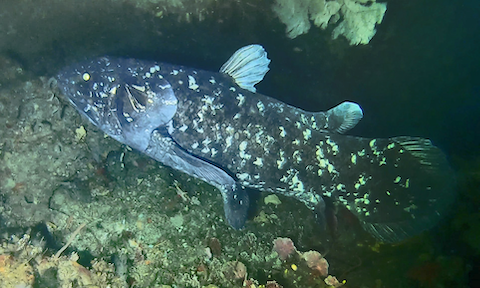
In the 1800s, scientists found a 400-million-year-old fossil fish they thought could be the missing link between aquatic and land-dwelling creatures. They would have loved to study it, but it had gone extinct with the dinosaurs.
Or so they thought. Until 1938, when a museum curator saw a fisherman haul one out of his net in South Africa. She wrote a hasty telegram to her museum. They wrote back: “Get that fish!”
She had found the coelacanth, not extinct after all, but hiding for millions of years in the Indian Ocean.
True to the fossil, it had small pectoral fins, on arm-like stalks, connected to joints like shoulders, and a wide fleshy tail.
According to local reports, it was so oily and foul tasting that anyone who tried to eat it would become sick. Which probably helped this slow growing living fossil keep on living.
And researchers soon found it’s very slow indeed. Coelacanths can grow to 200 pounds and live to 100 years but don’t reach sexual maturity until they hit 50.
Females incubate eggs within their abdomen, which take 5 years to hatch, then emerge as live young—the longest gestation of any animal.
It turns out, however, the coelacanth wasn’t the missing link that scientists hoped for. That honor belongs to its relative, the lungfish, which crawls out of the water to make short journeys on land.
Background
Synopsis: Coelacanths, pronounced \ ˈsē-lə-ˌkan(t)th \, evolved more than 400 million years ago, and along with their lungfish cousins, are thought to be an evolutionary link to land-based animals. The youngest fossil specimens are 66 million years old, so scientists believed the fish suffered extinction at the same time as the dinosaurs. But in 1938, amazed researchers spotted one in a fisherman’s net in South Africa, and the elusive centenarians still continue to astonish. Originally, the fish were thought to attain their huge 6.5 ft (2 m) size in just 20 years, but recent studies show it takes five times that long—100 years. They don’t breed until they are at least 40, and females gestate developing eggs within their body for 5 years before giving birth to live offspring. This protracted life cycle further increases the vulnerability of these critically endangered living fossils.
- The Devonian Period lasted 60 million years, from 420 to 360 million years ago, and is known as the Age of Fishes.
- With increasing atmospheric oxygen levels, fish populations exploded while primitive ferns and conifer forests spread across the land and insects like dragonflies took to the air.
- The supercontinent of Gondwana filled most of the Southern Hemisphere and sea level was high, submerging some continental areas.
- Two types of bony fishes evolved in the extensive northern sea.
- Ray-finned fish are the ancestors of modern fish, with characteristic paired pelvic and pectoral fins.
- Lobe-finned fish are distinguished by fleshy lobes that connect their fins to the shoulder or pelvis with a single humerus or femur bone, like modern reptiles.
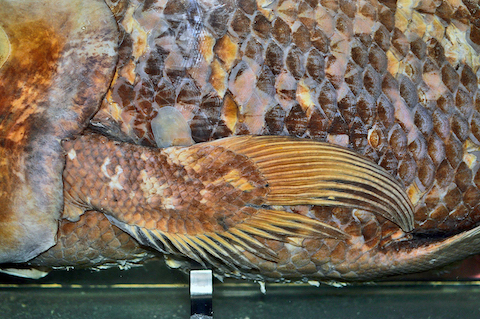
In contrast to the ray-type fins of modern fish, the lobe-type pectoral fin of a coelacanth connects to a shoulder-like joint by a single flesh covered humerus bone, similar to reptilian appendages. Credit: Citron / CC-BY-SA-3.0, https://creativecommons.org/licenses/by-sa/3.0/ via Wikimedia Commons - Lobe-finned fish were the more common group in Devonian times, but, except for lungfish and coelacanths, they are now all extinct.
- Lobe-finned fish are thought to be the ancestors of all land-based tetrapods.
- Fossils of lobe-finned coelacanths were first studied and classified in the 1830s.
- The first published description of a coelacanth can be found in Louis Agassiz 1839 book Poissons Fossiles. Darwin also had interest in the transitional species.
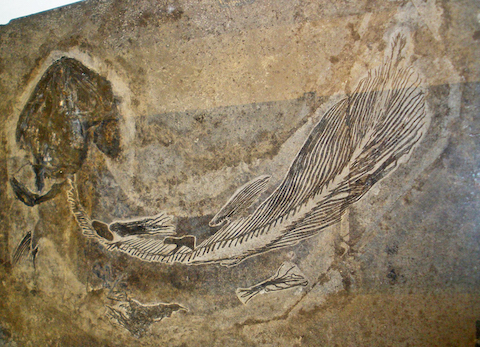
Fossil of Coelacanthus granulatus an extinct coelacanth that flourished in the Permian Period around 250 million years ago. It was named by Louis Agassiz in 1839. Credit: Ghedoghedo, CC BY-SA 3.0 <https://creativecommons.org/licenses/by-sa/3.0>, via Wikimedia Commons - More than 100 fossil species of coelacanths have been described, ranging in age from 410 to 66 million years, and peaking around 250 million years ago in the early Triassic Period.
- Paleozoic fossils are more diverse in shape and smaller, around 1 ft (30 cm) long, while Mesozoic coelacanths had similar shapes and grew to lengths of more than 16 ft (5 m).
- The lack of any Cenozoic fossils caused researchers to believe coelacanths became extinct at the end of the Cretaceous Period along with the dinosaurs.
- The first published description of a coelacanth can be found in Louis Agassiz 1839 book Poissons Fossiles. Darwin also had interest in the transitional species.
- Then, in December 1938, a museum curator saw one in a fisherman’s net while visiting South Africa’s Indian Ocean coast, surprising paleontologists around the world.
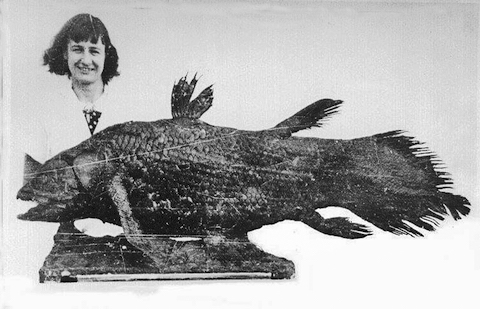
Marjorie Courtenay-Latimer, curator of the East London Museum in South Africa, stands beside the West Indian Ocean coelacanth specimen found in 1938 in the waters of South Africa’s KwaZulu-Natal Province. She said its scales were midnight blue with pearly white spots, like the starry sky. Credit: Public Domain - The next specimen wasn’t found until 1952 near the Comoro Islands.
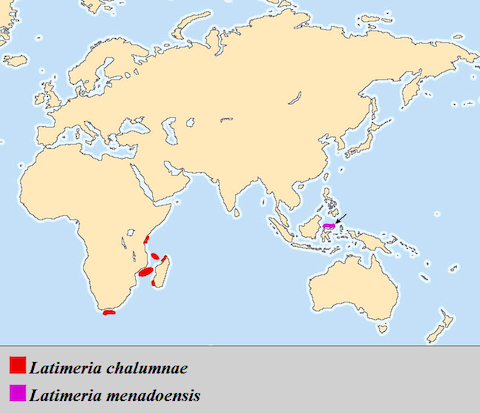
Modern range of coelacanths in southeastern African waters and in northern Indonesian waters of Suluwesi. Credit: Anaxibia, CC BY-SA 3.0 <https://creativecommons.org/licenses/by-sa/3.0>, via Wikimedia Commons - Today, a wild population totaling about 1,000 are known to live in in East African and Indonesian waters.
- The West Indian Ocean coelacanth (Latimeria chalumnae) has been found in the waters of Comoros, Kenya, Tanzania, Mozambique, Madagascar and South Africa.
- In the late 1990s, a second species was found in the waters of North Sulawesi in Indonesia, called the Indonesian coelacanth (Latimeria menadoensis).
- The next specimen wasn’t found until 1952 near the Comoro Islands.
- These elusive, gigantic, lumbering fish grow to lengths of up to 6.5 ft (2 m) and weights in the range of 200 lbs (90 kg).
- They have very slow metabolic rates and low oxygen extraction capacities that are dictated by the limitations of their hemoglobin.
- Submersible investigations over the years reveal that they live at water depths of 330–1640 ft (100-500 m), clustering together in dimly lit volcanic caves during the day and drifting toward reefs to feed at night.
- They move very slowly, conserving energy by using currents to assist most of their movement, but, if threatened, they use their seven unique lobe-shaped fins to maneuver adroitly out of harm’s way.
- Their critically endangered status prohibits fishing for them, so very few make it to the surface to be studied, leaving many details of their behavior a mystery.
- One big puzzle that remained was how long do these behemoths live?
- Normally, scientists examine inner ear stones called otoliths (with annual calcium carbonate layers that can be counted like tree rings) to determine a fish’s age.
- But to do that they have to break open the fish’s head, and, with such rare specimens, destructive investigation must be avoided.
- So, 1970s researchers turned to their scales, which grow up to 2 in (5 cm) long.
- These thick scales have visible ridges called circuli that could be counted. But how should they be counted?
- Counting one per year, scientists estimated the lifespan of the fish would be 22 years.
- The largest specimen would have grown to full size in 17 years, as fast as a speedy tuna grows. It didn’t make sense given their slow metabolism.
- Normally, scientists examine inner ear stones called otoliths (with annual calcium carbonate layers that can be counted like tree rings) to determine a fish’s age.
- During the pandemic, a couple of scientists decided to try a different method—using polarized light—as an unfunded side project. They were just having fun with a scientific conundrum while locked down.
- They had been working on a project to better define the lifespans of commercial fish to help with modeling future populations, so they ordered coelacanth scales from several institutions, and ended up with 27 specimens.
- Polarized light vibrates in a single plane, increasing contrast in certain materials.
- For each visible ridge, they found five very fine circuli in polarized light.
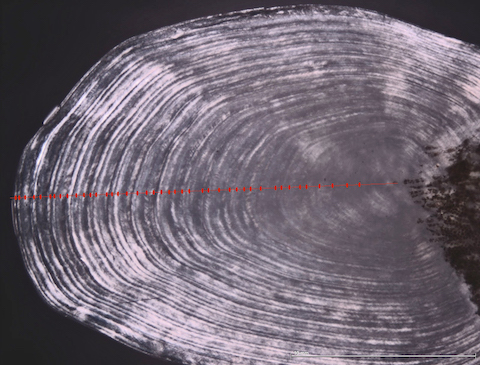
A coelacanth scale showing 5-year ridges and annual circuli in polarized light. Credit: Marc Herbin, Museum National D’Histoire Naturelle
- That meant the largest fish wasn’t just 17 years old, it was 85 years old! And the life expectancy of coelacanths was approaching 100 years.
- 85 years is a more reasonable time frame for a slow growing fish to reach a length of 6.5 ft (2 m).
- On top of that, they learned that the fish don’t reach sexual maturity until they are about 5 ft (1.5 m) long, and they don’t reach that length until they are at least 40 years old—some may not be able to breed until they are as old as 69!
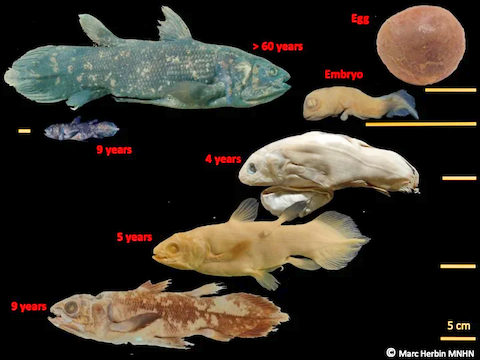
Coelacanth size ranges through its life span. The gold bar is 2 in (5 cm) in each photo. Credit: Marc Herbin, Museum National D’Histoire Naturelle
- Coelacanths carry their eggs within the female’s body until they are ready to hatch, a characteristic known as ovoviviparity. Then the juveniles are born live.
- Embryos in the belly of one female specimen were four years old, and the smallest juveniles were 5 years old, demonstrating the longest gestation known in the animal kingdom, more than twice that of the terrestrial record holder—the Indian elephant at 22 months.
- Like other long-lived species they produce small batches of eggs, only about 20 for each gestation, compared to some ray-finned fish that produce more than a million eggs per gestation.
- Scientists still aren’t sure why there is a bolder ring every 5 years, but they speculate it may have to do with the 5-year reproductive cycle. The bold bands don’t tie to environmental variations.
- Species with slow motion life cycles are some of the most vulnerable to changes in their environmental niches. This new research suggests that coelacanths may be more susceptible than previously thought.
- Researchers are continuing their studies with additional specimens and will study the width of the rings in warmer years to determine whether water temperature influences growth rate, which could postpone maturity, reproduction and further reduce populations in the future.
- Coelacanths have survived at least four major extinctions through adaptation over the last 400 million years.

